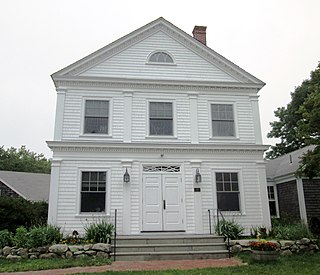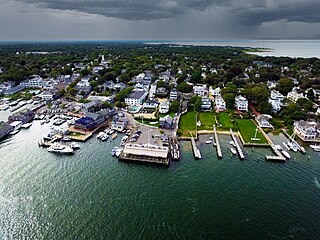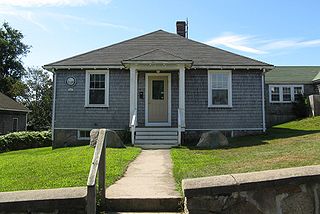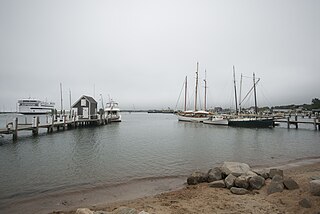


Monohansett was a sidewheel steamer operating as a ferry serving the island of Martha's Vineyard during the late nineteenth century. She was named after Monohansett Island, a tiny 12-acre (4.9-hectare) island off Naushon Island. [1]



Monohansett was a sidewheel steamer operating as a ferry serving the island of Martha's Vineyard during the late nineteenth century. She was named after Monohansett Island, a tiny 12-acre (4.9-hectare) island off Naushon Island. [1]
Monohansett was built in 1862 by the New Bedford, Martha's Vineyard, & Nantucket Steamboat Company as a replacement for the steamer Eagle's Wing, which had caught fire during a race on the Providence River off Pawtuxet in 1861 and was destroyed. The engine from Eagle's Wing was fitted into the new vessel. [2] Monohansett was built in five months in the shipyard of Thomas Collier of New York under the supervision of Monohansett's designer Captain Benjamin C. Cromwell of Vineyard Haven, Massachusetts. She was 182 feet (55 m) long, with a beam of 28 feet (8.5 m), 9 feet 6 inches (2.90 m) depth, and had a gross register tonnage of 489. [1] Her keel was made of white oak, her deck timbers were of oak and white chestnut, and her tops of hackmatack and white chestnut. [3] Monohansett made her first trip to Martha's Vineyard, to the Edgartown wharf, on June 1, 1862. [1]
Barely two months later, on August 13, 1862, the United States Government chartered Monohansett. [1] During the American Civil War, Monohansett carried dispatches to United States Navy ships operating in the Atlantic Ocean off Cape Hatteras and Wilmington, North Carolina, as well as in the Chesapeake Bay and the Potomac River. The small screw steamer Helen Augusta operated as the substitute ferry to Martha's Vineyard during the war. [2] By the end of the war in April 1865, Monohansett was the headquarters boat at City Point, Virginia, and was used by General Ulysses S. Grant as a dispatch boat. [1] General Grant reportedly was very fond of Monohansett, and President Abraham Lincoln and his wife also spent time aboard her. [3]
Monohansett returned to service as a Martha's Vineyard ferry in June 1865. [4] In the summer of 1874, now-President Grant used the Monohansett to visit Martha's Vineyard, arriving in Cottage City (now Oak Bluffs). [1]
Monohansett was first commanded by Captain Benjamin C. Cromwell, her designer, and during the American Civil War by Hiram Crowell. [3] Captain Charles C. Smith (b. 1826), who served as first mate under Captain Crowell during war duty, became captain of Monohansett in 1867 and was still master in 1885. [4]
Although Monohansett was primarily a Vineyard boat, she occasionally would make trips to Nantucket, especially during wintertime "freeze-ups," when Monohansett would force her way through the ice to relieve the isolated Nantucket residents. [2]
Monohansett was sold in 1901 [1] or 1903 [3] (sources vary), and was used around Boston, Massachusetts, and the Massachusetts North Shore. On 3 August 1904, [5] she was wrecked in a dense fog on Little Misery Island in the Misery Islands in Salem Harbor, Massachusetts, while headed to Boston from Gloucester, Massachusetts. [2]

Martha's Vineyard, often simply called the Vineyard, is an island in the U.S. state of Massachusetts, lying just south of Cape Cod. It is known for being a popular, affluent summer colony, and includes the smaller peninsula Chappaquiddick Island. It is the 58th largest island in the U.S., with a land area of about 96 square miles (250 km2), and the third-largest on the East Coast, after Long Island and Mount Desert Island. Martha's Vineyard constitutes the bulk of Dukes County, Massachusetts, which also includes the Elizabeth Islands and the island of Nomans Land.

Nantucket is an island about 30 miles (48 km) south from Cape Cod. Together with the small islands of Tuckernuck and Muskeget, it constitutes the Town and County of Nantucket, a combined county/town government in the state of Massachusetts. Nantucket is the southeasternmost town in both Massachusetts and the New England region.

Dukes County is a county located in the U.S. state of Massachusetts. As of the 2020 census, the population was 20,600, making it the second-least populous county in Massachusetts. Its county seat is Edgartown.

Aquinnah is a town located on the western end of Martha's Vineyard island, Massachusetts, United States. From 1870 to 1997, the town was incorporated as Gay Head. At the 2020 U.S. census, the population was 439. Aquinnah is known for its beautiful clay cliffs and natural serenity, as well as its historical importance to the native Wampanoag people. In 1965, Gay Head Cliffs were designated as a National Natural Landmark by the National Park Service.

Chilmark is a town located on Martha's Vineyard in Dukes County, Massachusetts, United States. The population was 1,212 at the 2020 census. The fishing village of Menemsha is located on the western side of the town along its border with the town of Aquinnah. Chilmark had the highest median home sale price of any town or city in Massachusetts in 2013.

Edgartown is a town on the island of Martha's Vineyard in Dukes County, Massachusetts, United States, for which it is the county seat. The town's population was 5,168 at the 2020 census.

Gosnold is a town that encompasses the Elizabeth Islands in Dukes County, Massachusetts, United States. At the 2020 census, the town population was 70, making it the least populous town in Massachusetts. Most of the residents live in the village of Cuttyhunk, while most of the land in the town is owned by the Forbes family.

Oak Bluffs is a town located on the island of Martha's Vineyard in Dukes County, Massachusetts, United States. The population was 5,341 at the 2020 United States Census. It is one of the island's principal points of arrival for summer tourists, and is noted for its "gingerbread cottages" and other well-preserved mid- to late-nineteenth-century buildings. The town has been a historically important center of African American culture since the eighteenth century.

Tisbury is a town located on Martha's Vineyard in Dukes County, Massachusetts, United States. The population was 4,815 at the 2020 census.

West Tisbury is a town located on Martha's Vineyard in Dukes County, Massachusetts, United States. The population was 3,555 at the 2020 census. Along with Chilmark and Aquinnah, West Tisbury forms "Up-Island" Martha's Vineyard.

The Woods Hole, Martha's Vineyard and Nantucket Steamship Authority, doing business as The Steamship Authority (SSA), is the statutory regulatory body for all ferry operations between mainland Massachusetts and the islands of Martha's Vineyard and Nantucket, as well an operator of ferry services between the mainland and the islands. It is the only ferry operator to carry automobiles to and from the islands. The Authority also operates several freight vessels, thus serving as the main link for shipping any commercial goods that are not transported using the airports on Nantucket or Martha's Vineyard.

The River Queen was a sidewheel steamer launched in 1864. It soon became closely associated with President Abraham Lincoln and General Ulysses S. Grant while operating on the Potomac River, and was used for an unsuccessful peace conference in 1865 during the last year of the American Civil War. Later it operated as a ferry serving the islands of Martha's Vineyard and Nantucket during the late 19th century. Late in its career, it returned to the Potomac as an excursion vessel, and in 1911, it was destroyed in a fire.

The Island Home was a sidewheel steamer operating as a ferry serving the islands of Martha's Vineyard and Nantucket during the second half of the nineteenth century.

Martha's Vineyard was a sidewheel steamer operating as a ferry serving the island of Martha's Vineyard during the second half of the nineteenth century.

Uncatena was a sidewheel steamer operating as a ferry serving the island of Martha's Vineyard during the beginning of the twentieth century.

The Nantucket was a sidewheel steamer operating as a ferry serving the islands of Martha's Vineyard and Nantucket during the end of the nineteenth century and the beginning of the twentieth century. On the Vineyard it docked at Cottage City, Vineyard Haven, and the West Chop Wharf.

The Gay Head was a sidewheel steamer operating as a ferry serving the islands of Martha's Vineyard and Nantucket during the end of the nineteenth century and the beginning of the twentieth. It was named after the town of Gay Head, Massachusetts, later renamed Aquinnah.

Sankaty was a propeller-driven steamer that served as a ferry to Martha's Vineyard and Nantucket in Massachusetts; in Rockland, Maine; Stamford, Connecticut and Oyster Bay, Long Island in the United States from 1911 to 1940. During World War II, the ship was requisitioned by the Royal Canadian Navy for service as a minelayer and maintenance vessel along the Canadian Atlantic coast. Following the war the ship returned to a ferry, working the Wood Islands, Prince Edward Island and Caribou, Nova Scotia route in Canada from 1947 until 1964. While being towed to the breaker's yard, the ship sank off the coast of Nova Scotia on October 27, 1964.

Hy-Line Cruises is an American family owned and operated Massachusetts ferry and cruise company. The company currently operates the second largest passenger ferry service between mainland Cape Cod and the islands of Martha's Vineyard and Nantucket. The company also operates sightseeing cruises and fishing charters. The company's main office is located at 22 Channel Point Road in Hyannis.
The Nantucket forests have an unusual history. Continual salt saturated wind and nutrient poor soils set severe limits upon tree growth and the wood products that might be accessed by both indigenous peoples and colonial settlers.